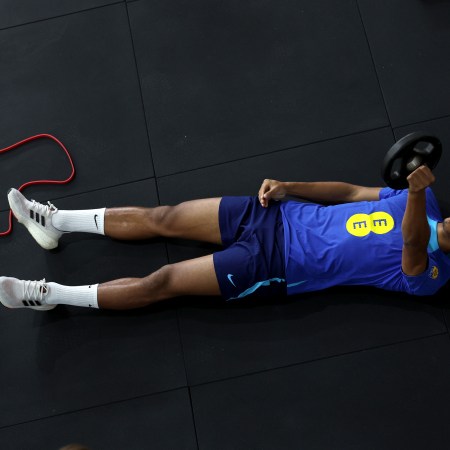When you jump off a 90-footer — the qualifying height for a professional cliff dive — you have three seconds before hitting the water. The surface tension rips through your muscles like a knife through butter.
Every. Single. Time.
It is a sport in which pain is nearly unavoidable.
“Even if you go in the water perfectly vertically and there’s no splash and you get tens from the judges, you still get ripped apart underwater,” explains Dave Colturi, who will be competing at Red Bull’s World Series on June 3-4 for the upstart sport this summer.
We recently spoke with him about how one goes about training for 90 foot dives into shallow water.
On the risks of diving from more than 90 feet into shallow water…
“One of the most common injuries is torn adductor muscles. That’s what happens on a perfect dive. So you can imagine what happens if you’re just slightly off vertical. Guys have been knocked unconscious if their chin is a little bit too far out. Worst case scenario is if you land completely flat — you can suffer internal hemorrhaging. There are injuries that you can incur that would be potentially fatal if they’re not taken care of immediately. Safety is the number one priority when we enter these competitions.”
On a cliff diver’s training regimen….
“Training is four-fold: We train at the USC Aquatic Center for in-water-training. There’s dry-land training, which is a collection of mats, trampolines and spotting harnesses above you so you can practice flips and twists without worrying about the landing. We practice a lot of modeling and take-off stuff in the dry-land gym. Then there’s the physical training gym with weights, plyometrics and cardio training for your explosive and dynamic muscles. Finally the mental aspect, and that’s something that everybody needs to work on all of the time because it’s hard to master: relaxation, breathing exercises, visualization, modeling and trying to put yourself in that environment so your body responds to the stress and fear you’ll go through and you’re able to do it like you’ve always done it.”
On those relaxation and breathing exercises…
“It can be done lying down and stationary. It’s a mental routine of trying to calm your heart rate with your breath while imagining that you’re on a platform 90 feet in the air. You can be in your bed and start thinking about this and your palms will sweat, your heart will beat faster, you’ll start to pump adrenaline through your veins just like you would when you’re up there. You need to calm yourself just the same way you would in that situation.”
Red Bull Cliff Diving World SeriesScouting waterfall dives with Dave Colturi and Jacqueline Valente2:09
On how to prepare for an event that only exists on the day of the competition…
“The only time we get to perform these dives is when we’re at the competitions. We have one or two days to practice on those, and as soon as the competition is over, the platforms are removed. You can try and find cliffs and do it yourself, but it’s really hard to find a consistent one and to do it safely. A lot of times you’re breaking the law and you’ve got to get a permit. We’re really limited to Olympic pools. We train at USC, but that’s a 10-meter platform. So we break the dive apart, practicing just the take off, then the mid-air somersaults and then the re-entry. Then you’ve got to go up to the competition, take it straight up and do it right away.”
On simulating unpredictable conditions…
“The pool here in L.A. at USC is outdoors, which is how it is at competitions. That was one of the more difficult transitions coming from traditional diving. In traditional diving, you train at an indoor aquatic facility and everything is controlled: the temperature, the climate, the pool deck … It’s always quiet; you don’t have deal with anything. Now you’re in Ireland. It’s rainy, it’s windy, there are waves, the crowd’s cheering. And you’ve got to pull it together when you’re used to jumping in a pool and everything is controlled.”
Red Bull Cliff Diving World SeriesUSA’s David Colturi leaps to first series win3:08
On his weekly training schedule…
“The HIIT (high-intensity interval training) workout is one in a series, and I get over to the gym about 3-5 days a week. It’s a very structured plan with some flexibility to do what I want depending on how I’m feeling. A lot of days we double up. We train 6-7 days a week and it’s anywhere from 1-3 workouts a day, and if you add that mental workout you’re doing four.
On his favorite exercises…
“Fun activities are my favorite form of exercise — ultimate frisbee or soccer, hockey, basketball. But if we’re talking in the gym, I really like HIIT and doing a lot of coordination and balance exercises, where you’re doing a squat on an endo-balance board, your feet are moving and you’ve got to keep your balance and focus on a lot more things. One of the reasons I moved out here is for the Red Bull headquarters in Santa Monica. The high-performance program in the gym they have is out of this world.”
On his diet…
“It’s tough to stick to a strict one because we travel so much. I try to push fruits and vegetables as often as I can. Just being smart and avoiding empty calories when I can. We’re not a cardio sport, so we’re not burning a bunch of calories.”
On his favorite cheats…
“I love live music and the music scene in L.A. is the best.”
This article was featured in the InsideHook newsletter. Sign up now.





















